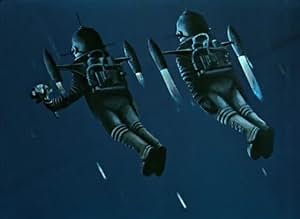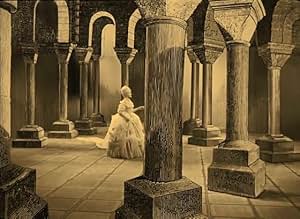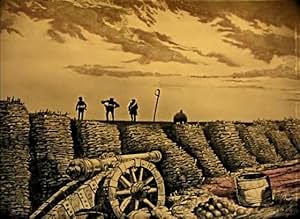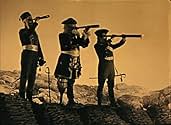IMDb RATING
7.7/10
3.3K
YOUR RATING
The outrageous Baron Munchausen tells of his many adventures, from meeting the Man in the Moon to defeating a Turkish army all by himself.The outrageous Baron Munchausen tells of his many adventures, from meeting the Man in the Moon to defeating a Turkish army all by himself.The outrageous Baron Munchausen tells of his many adventures, from meeting the Man in the Moon to defeating a Turkish army all by himself.
- Awards
- 1 win total
Nadezda Blazícková
- Court Dancer
- (as Nadesda Blazickova)
Featured reviews
In effect, the other commentary of this movie says everything that could be say for this excellent movie. I want to say that this movie and "On the comet (Na komete) are two of the best animation movies that I ever saw. I saw this movie in 35 mm at "Cinemateca Uruguayan" because there was playing a Karel Zeman's homage, but I think that it's necessary to review this classics films and to get it on VHS or DVD. Zeman is a genius director with the mix of animated stop-motion frames and people, filming in studios or in natural locations and also drawing over the negative, painting it, all the technics are used with masterly.
Karel Zeman was a genius if visual artistry. His playful use of 19th century engravings in a live-action movie is so original and it works so well. Everybody who praises the Gilliam's Munchhausen should hold the judgement until he sees this Munchhausen. If anybody from the video industry watches this database, please make this movie available at least on VHS. And once you are at it, I would add two more Zeman's films that are made with the same charm, technical wizardry, nostalgia and artistic vision: Vynalez zkazy (1958) ("The invention of Destruction" in English) and Blaznova kronika (1963) ("The Fools' Chronicles"). In the chronological order, I consider the three films a loose trilogy that uses the esthetics of the 19th, 18th, and 17th century, respectively, to study the timeless human situation.
10BugEye
Probably the most charming of the filmic adaptations of Raspe's 'Baron Munchausen". Czech animator Zeman creates a wonderland by combining live actors, animated models, and old prints to relate the Baron's marvelous adventures. A tour de force of the visual imagination.
By now, nearly everyone should be familiar with the Munchausen story or, at least, some portion of it even if shi didn't grown up on these German drinking boasts which got way out of hand.
This is not the first or last treatment of the braggart Baron, but this version has a charm that many others lack.
The film is shot, predominantly in sepia tone with occasional bits in exaggerated color for artistic emphasis. Those who recall the pink coat in Schindler's List will have some idea of what is happening. But, in this case, the effect is not so much an attempt to indicate a major event that was necessarily slighted in the film. Rather, it helps to emphasize the aspects of the fantastic and the fairy tale romanticism that the director is emphasizing.
The live actors are shot against an animated background and are often blithely unaware of the fantastic things that are sweeping around them while they concern themselves with the essentially silly issues of their lives. This is Czech animation which seems rather exotic to those of us raised on Disney-esque 'realism'. Still, it's stylism adds a charm to the film that helps to reinforce the multiple layers that the director has built into this piece.
You should not attempt to become involved in the film so much as to sit back and marvel at the world that is passing unobserved by those passing through it.
When it has finished,you will want to watch it again and again to catch how all the different visual layers interact in your mind if not on the screen.
If I had to compare this effect to any other film, I suppose I would choose the way that Altman weaves the foreground and background into the midground in "M*A*S*H", though the two films are very different and have completely different statements about the world.
This is a fantasy and it is truly fantastic, but only on an adult level. Children will have many questions that all come down to 'why is it happening that way?' For children, fantasy is a chance to dream dreams and play games. This is a film for adults that has found an adult way to present the wit and contradiction of the original stories while acting out the ingenuousness of the characters' actions.
See this one. It deserves your attention.
This is not the first or last treatment of the braggart Baron, but this version has a charm that many others lack.
The film is shot, predominantly in sepia tone with occasional bits in exaggerated color for artistic emphasis. Those who recall the pink coat in Schindler's List will have some idea of what is happening. But, in this case, the effect is not so much an attempt to indicate a major event that was necessarily slighted in the film. Rather, it helps to emphasize the aspects of the fantastic and the fairy tale romanticism that the director is emphasizing.
The live actors are shot against an animated background and are often blithely unaware of the fantastic things that are sweeping around them while they concern themselves with the essentially silly issues of their lives. This is Czech animation which seems rather exotic to those of us raised on Disney-esque 'realism'. Still, it's stylism adds a charm to the film that helps to reinforce the multiple layers that the director has built into this piece.
You should not attempt to become involved in the film so much as to sit back and marvel at the world that is passing unobserved by those passing through it.
When it has finished,you will want to watch it again and again to catch how all the different visual layers interact in your mind if not on the screen.
If I had to compare this effect to any other film, I suppose I would choose the way that Altman weaves the foreground and background into the midground in "M*A*S*H", though the two films are very different and have completely different statements about the world.
This is a fantasy and it is truly fantastic, but only on an adult level. Children will have many questions that all come down to 'why is it happening that way?' For children, fantasy is a chance to dream dreams and play games. This is a film for adults that has found an adult way to present the wit and contradiction of the original stories while acting out the ingenuousness of the characters' actions.
See this one. It deserves your attention.
It begins with cosmonaut Rudolf Jellinek landing on the moon. He follows footprints which lead him to the gentlemen of Jules Verne's expedition. They introduce him to their seniors on the site: Cyrano de Bergerac and the Baron Munchausen. Munchausen takes the Moon Man (for so he must be) on a trip to the Earth in what appears to be the 18th century. There they rescue the fair princess Jana Brejchová from the Sultan of Turkey and go on a series of imaginative adventures.
It must have been a dangerous movie to produce in Czechoslovakia in 1962. It celebrates imagination. It's not even imagination in the service of anything except itself. It's the imagination of a boy, just looking up from his loved library of Jules Verne and Alexandre Dumas and noticing girls for the first time. The set designs reinforce this. They look like Dore steel engravings, and the stock is toned, occasionally for what seems to be early two-strip Technicolor, with flashes of bright colors. Munchausen fights ten thousand bashi-bazouks; he flies about on cannonballs and dwells in a whale for months. He does whatever he pleases, as the fancy strikes him, and Jellinek follows along. Will he ever develop an imagination of his own?
It's clear to me that Terry Gilliam mined this movie extensive for his own MUNCHAUSEN; there are too many settings and incidents for it to be otherwise. He would have been 24 when it premiered in the US at Pacificon. I have no doubt that he saw it there and it left an impression in his mind at least as great as in my own.
It must have been a dangerous movie to produce in Czechoslovakia in 1962. It celebrates imagination. It's not even imagination in the service of anything except itself. It's the imagination of a boy, just looking up from his loved library of Jules Verne and Alexandre Dumas and noticing girls for the first time. The set designs reinforce this. They look like Dore steel engravings, and the stock is toned, occasionally for what seems to be early two-strip Technicolor, with flashes of bright colors. Munchausen fights ten thousand bashi-bazouks; he flies about on cannonballs and dwells in a whale for months. He does whatever he pleases, as the fancy strikes him, and Jellinek follows along. Will he ever develop an imagination of his own?
It's clear to me that Terry Gilliam mined this movie extensive for his own MUNCHAUSEN; there are too many settings and incidents for it to be otherwise. He would have been 24 when it premiered in the US at Pacificon. I have no doubt that he saw it there and it left an impression in his mind at least as great as in my own.
Did you know
- TriviaDirector Terry Gilliam saw this film at the British Film Institute (BFI) while preparing his own adaptation of the same novel, Les aventures du baron de Munchausen (1988), and subsequently referenced some of this film's scenes in his own adaptation.
- Quotes
Cyrano D'Bergarac: I cast my hat out into the universe, let it greet those who are on thier way from earth. From this day forward, the moon is no longer a dream....
- ConnectionsFeatured in Karel Zeman detem (1980)
- How long is The Fabulous Baron Munchausen?Powered by Alexa
Details
- Release date
- Country of origin
- Language
- Also known as
- The Fabulous Baron Munchausen
- Production companies
- See more company credits at IMDbPro
Contribute to this page
Suggest an edit or add missing content




































